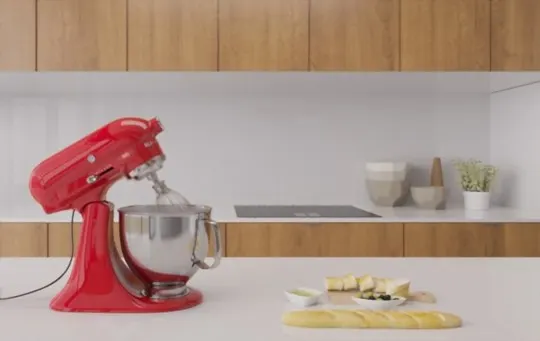In the kitchen, mixers are a must-have. Wolf Mixer and KitchenAid stand tall in this arena. Each has its fans and unique features. We’ve all had that moment of indecision at the store.
Which one will transform our baking game? Let’s find out together. We’ve used them both. Yep, from whipping cream to kneading dough, we’ve put them through their paces.
Expect a no-nonsense breakdown. We’re talking facts, laughs, and maybe a shared tear over failed meringues.
What is a Wolf Mixer?

Wolf Mixer is a powerful and versatile kitchen appliance used for baking and cooking purposes.
It is a premium brand that offers high-quality mixers, known for their durability, efficiency, and performance.
Compared to other mixers in the market, Wolf Mixer stands out due to its unique features such as variable speed options, dough hook attachments, and large mixing bowls.
These mixers can handle heavy-duty tasks with ease and deliver consistent results every time.
What is a KitchenAid Mixer?

KitchenAid Mixer is a versatile and powerful appliance used in kitchens worldwide.
It is an electric device that helps mix, blend, and knead ingredients conveniently for making various recipes.
It consists of a mixing bowl, several attachments like whisks, paddles, and hooks.
With its exceptional performance and durability, KitchenAid stand mixer has become a household name.
The motor-powered KitchenAid Mixers are faster than hand mixers as they can handle tough doughs and larger quantities of ingredients.
With its ample capacity ranging from 3 to 7 quarts in size, it serves multipurpose kitchen needs.
The KitchenAid mixer’s wide range of colors, design options, and accessories make it a favorite of home bakers and chefs alike.
Comparison of Wolf Mixer and KitchenAid Mixer

Both Wolf Mixer and KitchenAid Mixer are highly efficient kitchen appliances that come with their unique features.
While KitchenAid mixers have been a household name for quite some time, Wolf Mixer is a relatively new entrant in the market.
Both stand mixers offer heavy-duty motor power required to knead dough, whip up cream, and blend batters.
Design and Build Quality
The build and design of Wolf Mixer and KitchenAid are noteworthy to compare.
Wolf Mixers offer high-quality mechanisms, comprising of sturdy metal housing that’s resistant to wear.
The KitchenAid, on the other hand, is impressively designed with attention to detail, offering a sleek finish that complements your kitchen’s aesthetics.
However, both appliances come equipped with an anti-slip base feature for safety measures when mixing challenging ingredients.
It’s notable that blending attachments such as dough hooks and whisks do vary between each appliance model.
Wolf Mixers offer generous-sized handles with structural designs explicitly made for comfortable grip; this makes it easy to mix large quantities of substance quickly without compromising on quality or results.
KitchenAid provides durable stainless steel hooks with an arched wing design for easy mixing of even hard-to-reach spots within larger mixtures.
Ultimately, both appliances offer top-notch build quality and innovative designs tailored explicitly for making life easier in households.
It’s worth emphasizing that while both options boast superior construction quality and modernized aesthetics, each presents unique features appealing to diverse buyer preferences.
For instance, one may prefer Wolf Mixer’s handle design over KitchenAid’s stainless-steel hooks or vice versa depending on individual needs.
The next section will delve into their performances further but keep in mind the importance of choosing according to your preferences when shopping for these state-of-the-art stand mixer brands available in market today.
Performance and Power
The Wolf Mixer and KitchenAid mixers are designed to offer outstanding performance and power.
Both brands have various models that cater to different levels of demand from the end user.
With powerful motors and versatile settings, they’re ideal for kneading dough, whisking egg whites, mixing cake batter, and more.
The mixers come with attachments like paddle, whisk, and dough hook to offer superior mixing efficiency.
When it comes to performance, the Wolf Mixer boasts a heavy-duty construction with a durable bowl-lift design that can handle large batches without losing power or efficiency.
Its high-torque motor ensures reliable operation even when handling thick mixes.
Additionally, the mixer has seven-speed settings that allow you to adjust speed depending on your needs.
On the other hand, KitchenAid mixers are known for their iconic design and versatility in performance.
With over 20 models ranging from mini models to pro-grade options, there’s a KitchenAid mixer for everyone.
The mixers come with powerful motors that range from 250 watts to 1 horsepower depending on the model.
And they’re sturdy enough to handle frequent use while still delivering consistent results.
In summary, both Wolf mixers and KitchenAids are definitively powerful and efficient models while boasting unique features such as size variations and compatibility with numerous accessories perfect for catering to diverse baking demands at home or commercially.
Attachments and Accessories
The different attachments and accessories available for the Wolf Mixer and KitchenAid can enhance the overall experience of using these appliances.
The accessories include a pasta roller, meat grinder, ice cream maker, juicer, and more.
These additional tools allow for greater versatility in the kitchen and can simplify the process of achieving certain recipes.
In addition to the standard attachments, each brand also offers unique add-ons that set them apart from each other.
For example, Wolf Mixers offer a grain mill attachment, while KitchenAid has a vegetable sheet cutter that allows for easy slicing of vegetables into sheets for use as wraps or noodles.
Investing in additional attachments and accessories may require extra cost but can ultimately enhance your cooking experience and allow you to create even more dishes with ease.
Consider researching which brands offer the specific attachments you need before making any purchases.
Price Range
Wolf Mixer and KitchenAid differ in their price range.
While Wolf Mixers are typically higher-end, professional-grade products that range from $500 to $1000, the KitchenAid appliances have a wider spectrum, ranging from about $200 for a basic model up to $500 for more advanced versions.
However, it’s worth noting that KitchenAid models also include various promotions and sales year-round.
In terms of price, KitchenAid is generally considered the more affordable option for most consumers.
Key Similarities Between Wolf Mixer and KitchenAid Mixer
Wolf Mixer and KitchenAid Mixer share more similarities than differences.
Both mixers have a sleek design, powerful motor, and multiple speed settings.
They are suitable for blending, mixing, and kneading dough.
However, KitchenAid offers more customization options with a wide range of mixer attachments to expand its functionality.
Additionally, Wolf Mixer is relatively new in the market and comes with an expensive price tag compared to KitchenAid.
Regardless of the slight variations, both mixers are high-quality products that can elevate your cooking experience.
Factors to Consider When Choosing Between Wolf Mixer and KitchenAid Mixer

When deciding between the Wolf Mixer and KitchenAid Mixer, there are several factors to consider.
These include mixing capacity, motor power, design features, and attachments.
Both mixers have unique strengths making the choice a matter of personal preference.
In terms of mixing capacity, the Wolf Mixer has a larger bowl size of 7 quarts compared to KitchenAid’s 5-6 quart options.
However, KitchenAid offers more powerful motor options ranging up to 1,3 horsepower while Wolf only goes up to 0.
9 horsepower.
Additionally, KitchenAid offers more color variations and design features such as tilt-head models and retro vintage looks.
It is important to note that both mixers come with various attachments such as dough hooks, flat beaters, and wire whisks providing versatility in their uses for baking needs.
Nonetheless, the varying factors can make choosing between the two a challenging decision for any home baker or professional pastry chef alike.
Kitchen Size and Counter Space
When considering which mixer to choose, the size of your kitchen and counter space is a crucial aspect to consider.
The Wolf Mixer and KitchenAid models vary in size, with the Wolf Mixer being larger and heavier than the KitchenAid.
If you have limited countertop space, the smaller size of the KitchenAid may be a better fit.
However, if you have a spacious kitchen and frequently bake in large quantities, the larger size of the Wolf Mixer may be more beneficial for your needs.
Another factor to consider is storage space when the mixer is not in use.
The Wolf Mixer takes up more room due to its heavier weight, whereas the lighter KitchenAid can be easily stored away when not in use.
It’s important to measure your countertop space before purchasing either model to ensure that it will fit comfortably.
Additionally, think about how often you plan on using your mixer and what types of recipes you’ll be making to determine which size is most suitable for your needs.
Specific Cooking and Baking Needs
For those with specific cooking and baking needs, choosing the right mixer can make a significant difference in their culinary endeavors.
While Wolf Mixer and KitchenAid are both reputable brands that offer high-quality mixers, there are some key differences to consider.
Wolf Mixers offer variable speed control which makes them particularly useful for professional chefs and home cooks who require precise mixing outcomes.
They also have a heavy-duty construction that makes them suitable for tough doughs and large batches.
On the other hand, KitchenAid mixers come in a wide range of colors, designs, and sizes to match various personal styles and preferences.
Additionally, many of their models come with multiple attachments such as pasta rollers, meat grinders, and grain mills.
It’s worth noting that while Wolf Mixers may be expensive upfront, they often last longer due to their durability which makes them cost-effective in the long run.
In contrast, KitchenAid’s widespread popularity means it’s readily available at various price points with an extensive service network.
Ultimately it comes down to personal preference – if you prioritize control over mixing precision or design over functionality will influence your decision between a Wolf Mixer or a KitchenAid respectively.
Budget and Long-Term Investment
For those looking to invest in a quality kitchen appliance, the decision between ‘Wolf Mixer vs KitchenAid’ may come down to more than just price points.
When considering budget and long-term investment, it is important to not only take into account the initial cost but also the durability and performance of the appliance over time.
In terms of budget, KitchenAid may be a more affordable option upfront.
However, when considering longevity and durability, Wolf Mixer may offer a higher return on investment due to its heavy-duty construction and powerful motor.
Its stainless steel bowl and mixing attachments are also designed for long-lasting use.
Furthermore, investing in a Wolf Mixer means having access to their exceptional customer service and support.
The company’s comprehensive warranty plan includes coverage for parts and labor for up to five years, giving customers peace of mind knowing their investment is protected.
When making an investment in a high-quality kitchen appliance, it is important to carefully consider factors beyond just the initial cost.
While KitchenAid may be a more affordable option upfront, Wolf Mixer’s superior durability and customer service make it a strong contender for those looking for a long-term investment in their kitchen equipment.
Conclusion
As we have compared Wolf Mixer and KitchenAid mixers in detail, there are notable differences between the two.
While both have their unique features and functionality, one may be more suitable than the other based on individual preferences and needs.
To make an informed decision, it’s essential to assess your baking and cooking requirements before making a purchase.
Factors like price, power, capacity, speed options, design details and warranties should also be considered when picking a mixer.
Regarding power and capacity, the Wolf stand mixer has a larger bowl capacity than the KitchenAid mixer but won’t match its high-speed motor.
On the other hand, KitchenAid is well known for its quality build that can last for years with proper maintenance.
Additionally, if you consider aesthetics crucial in your kitchen appliances – both brands come with great design options from which you may choose.

Leave a comment